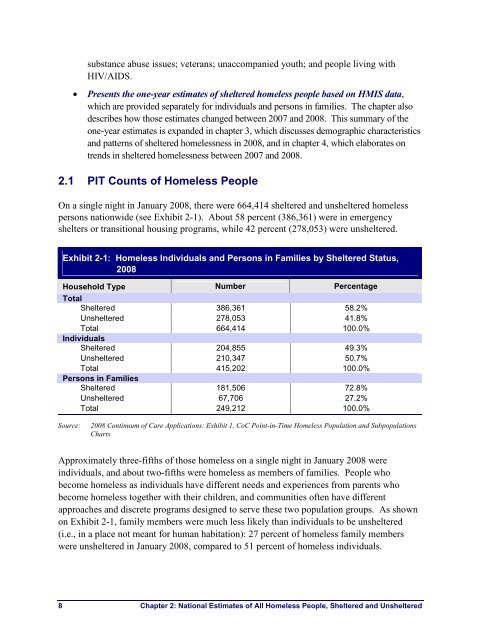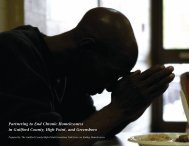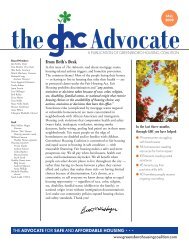data - Greensboro Housing Coalition
data - Greensboro Housing Coalition
data - Greensboro Housing Coalition
Create successful ePaper yourself
Turn your PDF publications into a flip-book with our unique Google optimized e-Paper software.
substance abuse issues; veterans; unaccompanied youth; and people living with<br />
HIV/AIDS.<br />
<br />
Presents the one-year estimates of sheltered homeless people based on HMIS <strong>data</strong>,<br />
which are provided separately for individuals and persons in families. The chapter also<br />
describes how those estimates changed between 2007 and 2008. This summary of the<br />
one-year estimates is expanded in chapter 3, which discusses demographic characteristics<br />
and patterns of sheltered homelessness in 2008, and in chapter 4, which elaborates on<br />
trends in sheltered homelessness between 2007 and 2008.<br />
2.1 PIT Counts of Homeless People<br />
On a single night in January 2008, there were 664,414 sheltered and unsheltered homeless<br />
persons nationwide (see Exhibit 2-1). About 58 percent (386,361) were in emergency<br />
shelters or transitional housing programs, while 42 percent (278,053) were unsheltered.<br />
Exhibit 2-1: Homeless Individuals and Persons in Families by Sheltered Status,<br />
2008<br />
Household Type Number Percentage<br />
Total<br />
Sheltered 386,361 58.2%<br />
Unsheltered 278,053 41.8%<br />
Total 664,414 100.0%<br />
Individuals<br />
Sheltered 204,855 49.3%<br />
Unsheltered 210,347 50.7%<br />
Total 415,202 100.0%<br />
Persons in Families<br />
Sheltered 181,506 72.8%<br />
Unsheltered 67,706 27.2%<br />
Total 249,212 100.0%<br />
Source:<br />
2008 Continuum of Care Applications: Exhibit 1, CoC Point-in-Time Homeless Population and Subpopulations<br />
Charts<br />
Approximately three-fifths of those homeless on a single night in January 2008 were<br />
individuals, and about two-fifths were homeless as members of families. People who<br />
become homeless as individuals have different needs and experiences from parents who<br />
become homeless together with their children, and communities often have different<br />
approaches and discrete programs designed to serve these two population groups. As shown<br />
on Exhibit 2-1, family members were much less likely than individuals to be unsheltered<br />
(i.e., in a place not meant for human habitation): 27 percent of homeless family members<br />
were unsheltered in January 2008, compared to 51 percent of homeless individuals.<br />
8 Chapter 2: National Estimates of All Homeless People, Sheltered and Unsheltered




